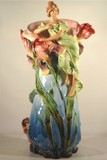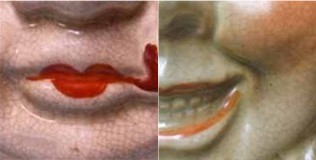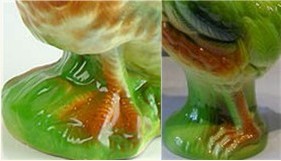|
ANTIQUE VICTORIAN MAJOLICA
A Collector's Guide to Authentication
& Spotting Repros and Fakes
What it is, what it isn't, where it came from, and how to recognize
it
 Where it came from: Majolica (pronounced
"mah-joll-ick-ah", with an accent on the "joll"), as we think of it today, is a fairly recent invention,
having been created in 1851 by Herbert Minton and Leon Arnoux, of the famous Minton company in Great Britain. Both
men were fascinated by the arts of the Italian Renaissance, including the Italian pottery known as maiolica. Inspired
by the historic maiolica, the two men developed a modern version and called it "imitation majolica" as an homage
to the pottery's Italian roots. What it is: By definition, majolica (with a J) is soft-paste earthenware
that has been fired to the biscuit stage, then coated with an opaque lead or tin (or both) glaze, which is allowed to
dry. After this preliminary glaze dries, the decoration is painted on with bright, colorful metal-oxide glazes. The
piece is then fired again, resulting in the brilliant and glossy finish for which majolica is most well-known. What it isn't: Being
brightly colored and glossy doesn't make a piece majolica, nor does the use of metal oxide glazes render a piece majolica.
Stoneware, parian, and creamware have all been known to be glazed with metal-oxide glazes--but they are still stoneware, parian,
and creamware, not majolica. Maiolica, the Italian forebear of majolica, also used an opaque tin glaze, which
was allowed to dry, then painted with metal oxide glazes, which were then fired. After this firing, the piece was then coated
with a clear lead glaze and fired again. This second glaze protected the colorful surface. Majolica's
Italian predecessor, Maiolica, is often seen without relief molding on the surface, while Victorian majolica
is almost always relief molded. Myth #1: All majolica
has a "wet bottom" (wet = glazed). This is completely untrue. There are many majolica pieces that
have unglazed bottoms or unglazed feet. This myth arose because all majolica had a preliminary opaque glaze of tin or
lead enamel on which the bright colored designs were painted in metal-oxide glazes. Sometimes pieces were dipped in this preliminary
glaze, hence the "wet bottom" myth, but just as often the preliminary glaze was painted on with a brush. A
dry bottom, feet, or table ring does not mean the piece is fake! Most often a dry bottom in found on somes pieces from continental
Europe, especially Austria and France. For example, The Art Nouveau vase shown below is a fairly common, well-known,
and documented piece from continental Europe, note the "dry bottom"!
Myth #2: Majolica was not made in a mold. This, too, is nonsense! Almost all
majolica was made in molds. In fact, I've never seen a piece that wasn't produced in a mold, although I suppose
theoretically it is possible. Every reference work on majolica mentions the molds, and the fact that the molds wore
out often and had to be replaced. Sometime in the latter half of the 20th century, the famous French majolica firm,
St. Clement, purchased the molds of the defunct, but just as famous, French majolica firm, Sarreguemines. If majolica
wasn't made in molds, I would think the St. Clement company would have known it!
Myth #3: All majolica
has subtle and refined colors. What? I'll just pull a few adjectives from my reference collection
that refer to the colors found on majolica: "brightly colored", "brilliant", "gaudy", "colorful",
to name a few. I think a picture says it best. Would you call these colors subtle and refined? Beautiful, yes!
But not subtle or refined! (Excuse the flash flare on the Palissy!)
Myth #4: All majolica has deep, crisp, and intricate detail. Again, this is total nonsense.
This is somewhat related to myth #2 mentioned above. While it's true that the most desirable pieces have deep
and crisp molding, not every piece of genuine majolica can make the claim. Molds wore out and the detail suffered as
the molds aged. I have seen marked English begonia leaf plates from the same year with every vein in the leaf lobe distinct
and clear, and seen the same plate with the same date and maker mark without a single apparent vein!
Myth
5: Majolica was not mass-produced and each piece is unique: This is really more of a half-myth, than a full one.
Majolica was mass-produced for the expanding middle class of the Victorian era. Thousands of nearly identical pieces
were made with only tiny variations between each piece. No two pieces came out of the factory absolutely identical because
each piece was hand-painted by a worker (usually a young girl) who tried to duplicate a master's copy of the piece.
This "master copy" sat before her on the workbench as a sample of how the piece should be painted.
Myth 6: Majolica was a very expensive, and "high art", product at the time: The
vast majority of majolica produced during the Victorian era was mass-produced, easily available, and relatively cheap. The
whole purpose of its introduction was to make the niceties indulged in by the wealthy available to the middle class.
It made it possible for this middle class to mimic at least some of the sumptuous lifestyle of the wealthy--a majolica
strawberry or oyster service was significantly less expensive than a fine porcelain one. With the exception of a handful
of makers such as Minton and Wedgwood, which did produce pieces which would qualify as "high art", majolica was
a fairly pedestrian product. In fact, as majolica lost public favor in the 1920's and 30's, it devolved to the
status of carnival favors and fairings. Myth 7: All majolica crazes over time and its presence
is an indication of age: Uhh, not quite. Crazing is a confusing topic, so let's start at the beginning.
Crazing is the tiny spiderweb-like crackled lines you can see in the glaze on many pieces of pottery, including majolica.
It is caused by the clay cooling and drying at a different rate than the glaze. Crazing can happen immediately upon
firing because the potter used unstable glazes; it can happen because of incompatibility between the clay and the glaze; it
can happen due to exposure to extremes in temperature and humidity; or it can happen as part of the normal aging process of
a piece of earthenware. Unfortunately, in an effort to deceive us, many modern reproductions are intentionally crazed
at the factory. The crazing on these pieces is oddly uniform and it is distinguishable from true age-crazing.
The photo below shows intentional crazing on modern majolica reproductions. Note the uniformity and the strangely flat
appearance of the crazing.
 Intentional crazing on modern Chinese import "majolica" humidors Intentional crazing on modern Chinese import "majolica" humidors
Compare
the photos above to the photos below. The pictures below show true age crazing on pieces that are more than 100 years
old. Note that the tan glaze in not stained while the aqua is. Crazing can stain due to exposure to water, food,
smoke, etc. But the presence of discoloration on crazing is not necessarily an indication of age. The fakes shown
above both demonstrate intentional staining. Notice that the authentic crazing below has sharper edges and generally
speaking, more acute angles than the fakes above.  Genuine age crazing on antique Victorian majolica Genuine age crazing on antique Victorian majolica
It is very
difficult to put this across with pictures on the internet, and I urge you to compare pieces in person. You will be
able to see the differences clearly when you have the pieces in hand. Once you become familiar with the look and feel
of the intentional crazing, you'll be able to distinguish it fairly easily, even in photos.
OK, if those are myths, what should I look for?
I
will be adding photos to this section soon, so please bear with me! It involves me intentionally buying fakes, which as a
collector, I am rather loathe to do!
Reputable dealers:
Whether you are shopping in a brick and mortar store or on the internet, buy only from people who will accept returns.
Anyone marketing something as majolica should stand behind what they sell. If something makes you doubt the authenticity
of a piece, you should be able to return it for a full refund.
Look for Hollow Handles:
Real vintage majolica pitchers, and other handled pieces, have solid handles. When you look inside a genuine piece,
you will see a solid interior. There is no little "hole" where the handles connect to the body. Ditto
for the applied figures on the lids of humidors. The lids of these antique humidors were solid with the figure applied
to the outside of the lid. If you can see down into the figure when you turn the lid over, you are looking at a recent
reproduction.
Incomplete Glaze on Interior: OK, let me be clear here. The color may not extend
all the way down the interior of a vase or other piece, it may fade to a natural biscuit color, but the glaze does extend
all the way. If you can see raw clay on the interior of a piece, it is recent (and probably Chinese).
Exterior
relief pattern is clearly visible on the interior: New majolica is made by slip-casting, and the exterior relief
is clearly visible on the inside of the piece. Old majolica was made by pressing the clay into the molds, making for
thicker walls. If the piece is thin and you can see every detail of the relief design on the interior, you are looking
at a new piece. Now that doesn't mean you can't see any change in shape on the interior, but if you can see
each flower petal, or twining vine, shy away from it unless you want a new piece!
A solid interior, but
a tiny hole in the handle: Some fake-makers are getting slick. They've learned that collectors are looking for
the tell-tale signs of a hole on the interior. So they've adapted, and are putting a tiny firing hole in the hollow
handle (or other projecting hollow part), but they're trying to hide it from you. Turn the piece upside down and
look at the very base of the handle--it's a favorite spot for hiding a firing hole!
Incised letters
M and W on the base: Some of the best reproductions carry this mark. Now, this isn't to say that there
are no authentic old pieces that might have these letters on the base. But if you find them, and see other indicators
that make you suspicious, it might be a good idea to take a pass on that piece!
Reddish-tan clay used on
"European" figural humidors: This one is a big tell! Just take a look at the interior rim of the
lid, or the table ring on the base, if it's red-tan, leave it alone. These fakes were made in imitation of highly
collectible antique Austrian and German figural majolica humidors. The genuine pieces will have a whitish clay, nothing
you would ever mistake for the fake reddish ones. Another good indicator of a true vintage continental European piece
is if it has impressed numbers in the base.
A brief word about Sarreguemines and St. Clement French Majolica
St. Clement, which is
still in business, is currently producing reproductions of some of their most popular vintage patterns, including dinnerware,
vases, and figural pitchers, such as the duck, rooster, duckling hatching, cat, penguin, and marabout (among others). All
of these pieces are available new in the St. Clement factory store in France. To complicate matters, St. Clement acquired
some of the old Sarreguemines molds when Sarreguemines went defunct, and they are producing some of the old Sarreguemines
products. None of these are being made or marketed by St. Clement as fakes; they are making them as current reproductions
of vintage pieces, but unfortunately, some people are selling them as vintage. The pitchers, especially, are popular targets.
Here are a few points to distinguish old from new.
 Detail photos of new St. Clement pitchers showing glassy glaze and "neon" green. Detail photos of new St. Clement pitchers showing glassy glaze and "neon" green.
Very glassy, glossy,
glaze: See the photos below of the parrot and duck. Notice the glaze is not glassy, as it is in the detail photos
of the feet on the new rooster and duck pitchers.
A very acid lime-green used on the piece: Compare
the greens used on the feet of the new duck and rooster pitchers to the green found on the old parrot and duck pitchers. This
neon green was beyond the technological scope of the time. If this color is present--it's not old!
Two examples of old St. Clement majolica pitchers
The wrong model numbers: Most old St. Clement animal pitchers will have a 3 digit model number or a 3 digit
with a slash and another number (222/4). Please note, I said "most", not all. There are a few rare examples
of 4 digit animal pitchers. The new animal pitchers usually have a 4 digit number. For instance, the new cat pitchers
carry the number 7486 on the base, while the old one has the number 525. The new monkey pitchers bear the number 7490 while
the old ones have 435.
A Sarreguemines mold marked St. Clement: The two Sarreguemines molds used
by St. Clement that I see most often in on-line auctions are the "Boar" (or Sanglier) with the number 5285 and the
"Pink Pig" (or Cochon Rose) with the number 3318. These are both Sarreguemines model numbers, but the pitchers
are marked with St. Clement marks.
That's all I have for now!I hope this has
been helpful, and I will try to add to it as I am able!
Return to Top
Return to Library
Return Home
Copyright 2008 Shantique Gallery
|
|
|
A Sampling of
Antique Victorian Majolica
from the
Shantique Gallery shop...
|
|
Antique French Majolica Garnissage Jardiniere This lovely French
majolica jardinière is glazed in ombre shades of green that shades from very deep forest green at the base to mint
green at the top. It is festooned with a large central flower in rose, white, and yellow, with twigs and foliage draped around
it and extending to the left-side handle in shades of blue-green, olive, and chocolate brown. A smaller opening bud in shades
of rose...See the item |
|
|
Antique Austrian Majolica Bros. Urbach Vase This very classically
styled vase is glazed in the muted colors of which the Brothers Urbach were so fond. Alternating columns of warm honey brown
bands with a criss-cross and floral design separateindented narrow panels of pale cream decorated with floral scrollwork glazed
in dove gray, charcoal gray and tan...This was made by the Brothers Urbach in Turn-Teplitz, Austria. It dates to between 1882
and 1906...See the item |
|
|
Antique German Majolica Villeroy & Boch Plate A double
ring of stylized snowdrops glazed in white and yellow with deep green foliage, all on a light mocha background, encircles
the center of this plate. The pierced border is accented with a band of stylized flowers glazed in aqua...It is clearly marked
on the back with the Villeroy & Boch impressed mark that was in use between 1895 and 1912. It also bears the impressed
numbers 1315 and 9. All plates are in superb condition with ...See the item |
|
|
Antique French Majolica St. Clement Figural Parrot Pitcher This
is a very old example of this famous pitcher. It was made at the faiencerie of St. Clement, near Luneville France sometime
in the 1910’s or 20’s. This venerable old pitcher began its life as a Garnier decanter for Crème de Cacao,
as evidenced by the opening on the back. Many people call these absinthe pitchers, but from my research, the ones made for
Garnier were used for Crème de Cacao. In fact, this one still retains its original little corkscrew attached ...See the item |
|
|
Antique Austrian Majolica Wilhelm Schiller Centerpiece I am
very pleased to offer this beautiful jardinière made by the renowned Wilhelm Schiller & Sons in Bodenbach (Bohemia),
Austria. It dates to around 1885-90. This unique mix of the traditional Victorian and Art Nouveau styles into one fluid effect
was typical of their workshop and shows a lovely marriage of the two predominant influences at the time....It bears Schiller’s
raised WS&S cartouche on the base as well as the impressed number 7721 and the word “Patent” ..See the item |
|
|
Antique French Majolica Art Nouveau Tubelined Vase
I
am very pleased to offer this lovely French Art Nouveau vase. A gorgeous Iris in shades of pink, yellow and purple, with leaves
in sky blue and fawn—all tube-lined—form the central motif...It is in superb condition with no chips, cracks,
repairs, etc. There is a very fine, tight hairline at the rim. See the photos for details. An identical vase can be seen on
page 74 of Jeffrey Snyder’s reference book, Marvelous Majolica, but he just identifies it as...See the item |
|
|
Antique French Majolica Garnissage Rose & Pansy Vase The
body of the vase is glazed in mottled shades of chocolate and mossy green with scrollwork handles mounted to the shoulders
of the vase by gargoyles. At the top, a wide turquoise glazed band ornamented with scrollwork contrasts beautifully with the
rest of the vase...There are no markings on this whatsoever, save the numbers 15 and 4, but in consultation with some French
colleagues, we feel this is probably Longchamp. Certainly the quality of the piece is every bit equal to Longchamp! This measures
15 ½” tall and...See the item |
|
|
Antique French Majolica Art Nouveau Ombre Vase
I adore this glaze
treatment and am always thrilled when I find a piece with it. This beautiful ombre-glazed vase shades from pale yellow at
the neck through warm honey and caramel, till you reach the base glazed in warm chocolate brown.... This style of vase was
the product of any number of small faienceries in the North of France, along the Belgian border. Few were marked, but the
reference book Les Barbotines, by Pierre Faveton shows this type treatment on page 32 and identifies them... see the item |
|
|
Antique Austrian Majolica Robert Hanke Floral Vase
A
large pink and green flower flares across the front of this vase, beautiful on its deep teal background.
The glazing is superb in shades of deep burgundy, buff, pale green, soft brown, and the palest of pink. This is not
marked, save with the impressed number 5679 and the number 95, but I am confident that it was made by Robert Hanke of Ladowitz,
Austria. His pottery operated from 1882 to 1903. Several things lead...In addition, I've had pieces in this pattern that
were marked...See the item |
|
|
Antique French Majolica Garnissage Double Corset Vase I
am very pleased to offer this lovely antique French majolica corset style vase. The body of the vase is glazed in cream accented
with faience-type décor at the base and around the reticulated rim. The front is accented with applied flowers, known
as garnissage, in shades of deep rose, cobalt blue, and green. The central flower appears to be a rose and the blue one…perhaps
forget-me-nots? The interior is glazed in deep pink. I find no maker’s mark on it, only the impressed number 1024 and
an illegible...See the item
|
We are a proud member of:
|
|